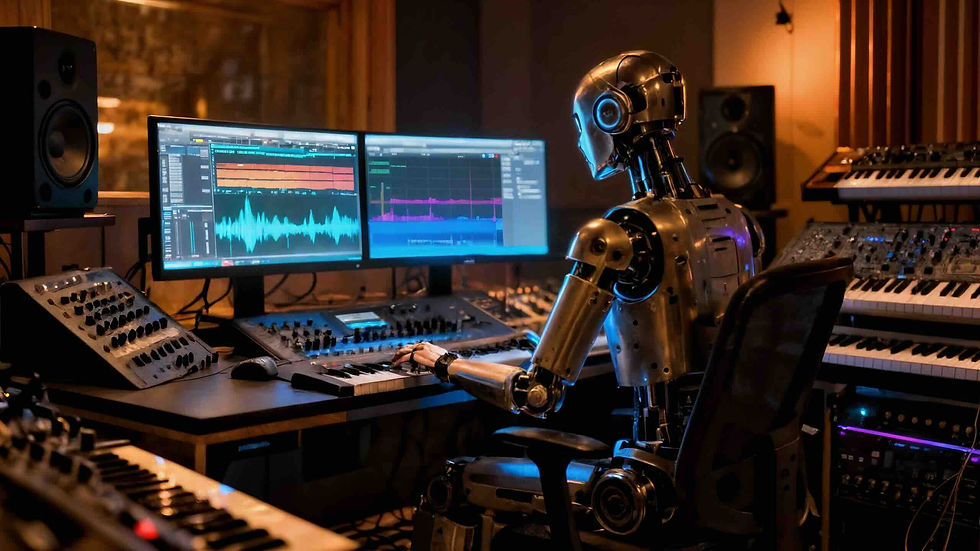AI in Music Production: The Biggest Shift Since the Sampler
- Leiam Sullivan
- Sep 17
- 3 min read

AI in music production is here, whether we like it or not. The thing is, you have to dive in and see what it’s about. There are so many AI music production tools emerging right now that bring fresh, exciting ways to make music–and they’re not just small tweaks, they’re completely changing workflows.
It’s a similar thing to when the sampler first appeared. Back then, time-stretching opened up a whole new world. Suddenly there were tracks with stretched-out vocals and chopped beats–sounds no one had ever heard before–which went on to define entire genres of electronic music.
We’re at the same kind of turning point now. If you’re not exploring AI, you’re going to miss entirely new ways to produce.
Why AI Is Changing Music Production
Take Logic’s stem splitter, for example. You can isolate a drum track from any full mix and really hear what’s going on without the rest of the music clouding it. Just as we sampled drums from records back in the day, we now have access to any drums from any track ever made.
Right now, the separated stems still have some artefacts–it’s not perfectly clean–but they’re good enough to give a production the right feel. You can tuck them back into the mix as a layer or reference point, much like how drum loops were used in the ’90s to add groove or provide a vibe to build around.
The same goes for other sounds within the split stems. Grab a single tone or element you’ve loved for years, drop it into Synplant 2, and suddenly you’ve got a whole new palette of textures to build with–fresh sounds born from the DNA of something familiar.
AI Tools in Action: From Stems to Whole Genres
You can generate an original disco track in Suno and sample it in the same way producers have been sampling classic disco records for decades. The same applies to hip hop or any genre built on sampling. Take a style that’s been heavily mined for decades, create a brand-new track in that space, and then sample it–just like producers have always done with old vinyl.
The difference now is that it’s completely original, so there are no copyright issues. By splitting your AI-created track into stems, you get clean, isolated parts: drums, basslines, strings, horns, vocals–ready to be chopped, flipped, and reimagined.
This approach breathes new life into sampling-based genres, opening the door to limitless creative possibilities.
Reverse-Engineering With AI
Breaking down stems isn’t just about sampling–it’s about learning. You can use AI tools to reverse-engineer the production techniques of your favourite tracks:
See exactly how a bassline moves and evolves.
Analyse the drum groove, swing, and timing.
Understand the layering and arrangement in detail.
This isn’t about copying someone else’s work. It’s about understanding the architecture of music, so you can take those insights and push your own ideas somewhere completely new.
Creativity, Ethics, and the Human Role
AI also raises big questions. Some fear it will replace musicians entirely. But here’s the thing: taste, emotion, and decision-making still come from you.
AI can generate raw material, but it’s the producer’s vision that shapes it into something meaningful. Just like samplers didn’t destroy music in the ’80s–they sparked entire new genres–AI is a tool. How it’s used depends on the artist.
That said, there are ethical considerations:
How AI models are trained (and whether they use copyrighted material).
Ownership of AI-generated works.
Ensuring artists are compensated when their creations influence AI outputs.
These questions will keep evolving, but they shouldn’t stop you from experimenting and exploring what’s possible right now.
The Future of AI Music Production
AI isn’t just a passing trend. Here’s what’s coming:
New genres driven by AI-generated soundscapes and hybrid human/AI collaboration.
Rapid prototyping for producers, letting ideas move from concept to demo in minutes.
Deep learning analysis that helps musicians understand arrangement, mix balance, and structure like never before.
AI used in live performance, adapting in real-time to crowds and environments.
The tools are evolving fast. If you experiment with them now, you’ll stay ahead of the curve. If you ignore them, you risk waking up to a scene that has moved on without you.
Conclusion: The Tools Are Here – What Will You Do With Them?
AI is opening doors to new workflows, textures, and ways of thinking about sound itself. It’s a revolution as significant as the rise of the sampler.
Dive in. Experiment. Learn. Because whether you embrace it or not, AI is shaping the future of music production–and the producers who explore it now will be the ones defining what comes next.




Comments